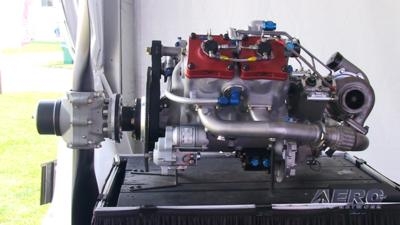Company Has Grown From Three To 45 Employees
After years of designing, refining and testing a new type of aviation engine, the owners and executives at DeltaHawk Engines believe they’ll start producing and selling engines later this year.

DeltaHawk is a privately held developer of general aviation engines, whose majority owners are Alan and Chris Ruud of the former Ruud Lighting. When the Ruuds bought into the company in 2015, Doug Doers —one of DeltaHawk’s founders, who led the engine design and engineering —said “This gives us the means to get the engine into production.”
Now, DeltaHawk executives are confident they will reach that stage this year. Company employment has grown from three when the Ruuds entered the picture to 45, and DeltaHawk is actively hiring. Most of those people are skilled engineers and different types of technicians.
“We struggled for many years because of a lack of funding,” Dennis Webb, director of marketing and certification, said. “And we made false promises — not on purpose.”
“(Alan and Chris Rudd) are known for growing businesses and, specifically, being market disrupters … the lighting business they fundamentally changed, both through how they went to market and adopting LEDs before anybody else," Webb said. “And Al is a passionate aviator. He saw this (DeltaHawk engine) as a market disrupter to aviation.”

Webb said the DeltaHawk engine design is pretty well finished, so now the company is doing testing and Federal Aviation Administration certification, which Webb said will be completed this fall. “Before, we thought we knew where we were at; now we know where we’re at,” Webb said. “We have passed some very brutal tests that we know pass FAA standards and regulations. We still have to show it to the FAA, but we’ve done the internal tests to show that we pass it structurally, and we pass it performance-wise … that’s why we know we’re going to get done.
“Literally every day I have communication with the FAA. It’s not like they’re going to walk in one day and say, ‘What’s this?’ ”
Another part of the process, he said, is FAA production certification. “Very simply, it’s ‘Your design meets regulations; now show us that you can make one of those every time.’ ”
Company executives expect to start slow production this fourth quarter, then ramp up production next year. Webb estimated they may need 30 to 40 additional employees when they start production, and DeltaHawk Chairman Alan Ruud said he expects they will employ hundreds of people within a few years.
The engines will be manufactured in cells — not assembly-line style.
Well before DeltaHawk manufactures its first engine for sale, it has a reputation, Webb said.
“I think in the general aviation world, our market space, which is light aircraft, I would say people are very aware of us,” he said. “Within the aircraft builders, they all know of us, for sure.”
With the Ruuds’ financial backing, DeltaHawk has been acquiring highly sophisticated equipment and rebuilding parts of its 72,000-square-foot building. Those investments include fixed-engine dynamometers, propeller dynamometers, data collection and analysis systems, a coordinate measuring machine that can measure to the two-millionth, a clean room for assembling precision components, engineering analysis tools and a new fabrication shop. A new research-and-development center also is planned.
“And things you can’t see as physical things,” Webb added, “and that’s extraordinary investment in computer simulation tools; we have state-of-the-art stuff, so that we can completely simulate what our engine will run like at this altitude, at this temperature, at this fuel flow, you know what it’s going to do.”
(Source: DeltaHawk news release derived from reporting from the Journal-Times newspaper. Image from file)
 ANN's Daily Aero-Term (04.26.24): DETRESFA (Distress Phrase)
ANN's Daily Aero-Term (04.26.24): DETRESFA (Distress Phrase) ANN's Daily Aero-Linx (04.26.24)
ANN's Daily Aero-Linx (04.26.24) Airborne 04.22.24: Rotor X Worsens, Airport Fees 4 FNB?, USMC Drone Pilot
Airborne 04.22.24: Rotor X Worsens, Airport Fees 4 FNB?, USMC Drone Pilot Airborne 04.24.24: INTEGRAL E, Elixir USA, M700 RVSM
Airborne 04.24.24: INTEGRAL E, Elixir USA, M700 RVSM Airborne-NextGen 04.23.24: UAVOS UVH 170, magni650 Engine, World eVTOL Directory
Airborne-NextGen 04.23.24: UAVOS UVH 170, magni650 Engine, World eVTOL Directory




